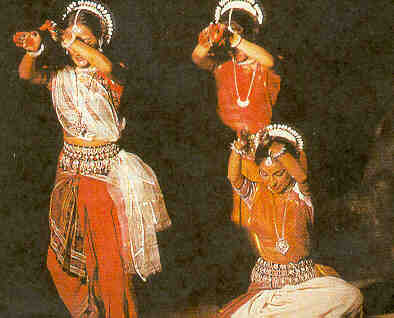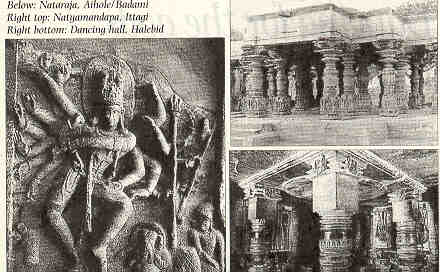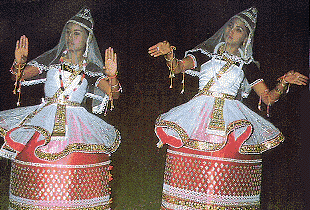|
|
Odissi
|
| Orissa, on the Eastern sea coast, is the home of the highly sensuous and lyrical
form known as Odissi. Like Bharatanatyam, it was intended to be performed in temples as a
religious offering by Maharis or devadasis. It has an intensely emotional and
lyrical structure and consists of literary compositions on the Krishna theme, the staple
being the 12th century poem Geet Govinda by Jayadev. Nritta and Nritya
or evenly balanced in a recital.

Odissi throbs with motifs reflecting sculptural design. Odissi is a dance of love and
passion, tender and intense. Inspired by temple carvings, its poses are statuesque at
vibrant.
Costume of Odissi is simple and colourful. Ornaments will be in silver colour unlike
Bharatanatyam which will be in gold colour.
Several treatises on Odissi written between the 16th and 19th
centuries and countless other references point to the fact, that three classes of dancers
were performing the style of dance. The dances of Maharis in the temples were basically
ritualistic. The Nartikis performed in the royal court and for the general public
at the traditional festivals like Vasantotsav. From around the 16th, another
class of dancers called Gotipua began to dance for the general masses.

Owing to extreme change in social values and gradual withdrawal of royal patronage, the
Nartikis were the first to disappear from the scene around the later part of the 19th
century. The Maharis continued to dance in the temple of Lord Jaganath at Puri till the 4th
decade of this century, but this dance has so much decayed that it was more a ritual than
dance. It was the Gotipua class of dancers who continued the tradition but their dance had
become so full of popular appeal that the classicism of dance had been diluted.
Odissi for centuries had been a solo dance. Now under the name of innovation group
performances are being presented. |
|
|
|
|
| |
|
|
|
|
|
 Indian Classical Dances
Indian Classical Dances
India has one of the richest cultural heritages in the
world. Its classical dance traditions date back 2000 years. Indian classical dance is a
synthesis of many arts.
 Bharathanatyam
Bharathanatyam
This dance which originated in the temples of TamilNadu,
specially from Tanjore and Chidambaram, was performed by Devadasi's in the olden days.
Graceful movements, mime, and music contribute in equal measure to this beautiful dance
from the South. The distinguishing features of "Bharat Natyam" are the noble,
almost geometrical angularity of movements and forceful foot-work.
 Mohiniyattam
Mohiniyattam
Mohini Attam or the dance of the Enchantress, originated in
the Southern most state of Kerala. This dance, unlike the other 2 South Indian styles, has
wide and swaying movements of the body and 15 more sensuous in style.
 Kathakali
Kathakali
One of the major Dance drams styles of India, has originated
from the lush, green Southern most state of India - Kerala. A traditional Kathakali
performance lasts all night and tells stories of heroes and heroines, Gods & Demons
from the Indian epics, Mahabharata and Ramayana. The techniques of Kathakali are extermly
complicated and the dancers, mainly men, excute rapid spins, leaps and freezes with split
second timings.
 Odissi
Odissi
Orissa, on the Eastern Sea-Coast of India, is the home of
the highly sensuous and lyrical form of dance called Odissi. This state is famous for its
temples, the Konarak, dedicated to the Sun God, The Jagannath Temple of Puri and many
more. The main features of this dance are its postures and sculpturous positions, closely
relating to the sculptures of the famous temples of Orissa. The Odissi dancer bends the
hips and sways the torso in curves and flexions known as "Tribhangi" (Triple
Bend) and "Atibhangi" (Semi-circular bend) from the torso downwards.
 Kathak
Kathak
A major solo style of Northern India, Kathak has
traditionally been danced by both men and women. This dance originated from the Braj
region in Uttar Pradesh by "Kathakars" or story tellers. With the advent of
Moghals in the North, Kathak moved from the temples to the courts or darbars of the Kings.
Thus this is the only dance where there is fusion of Hindu & Muslim culture. The
distinctive feature of Kathak is its brilliant foot-work, and an even motion with a rapid
tempo, the beauty and grace of movement is retained.
 Kuchipudi
Kuchipudi
Similar in many ways to BharatNatyam, this dance style which
originated as a ballet form of dance, from the village named Kuchupudi in AndhraPradesh,
has its own distinctive music and a more plastic or fluid line. It is only in recent times
that Kuchupudi has began to be performed solo and by Women.
 Manipuri
Manipuri
Manipur is located in the North Eastern part of Indian,
surrounded by mountain ranges, is famous for Manipuri dances, which is mainly devotional.
Lyrical grace, lightness of tread and delicacy of hand gestures, set Manipuri dance apart
from the geometric structure of BharatNatyam and the linear quality of Kathak. There are
also some vigorous Thadava or Musculine items called Cholam, in which the dancer leaps,
whirls and spins on the floor, while keeping rhythm on the drums slung from his neck.
 Links
Links
Here you will find a lot of other web sites related to
Indian Classical Dances. We really appreciate for visiting us.